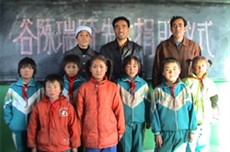At least 90% percent of donations pays for the FARS student's school fees, books, and/or room and board.

FOCAL POINTS
- Rural Youth Science Ca...
09/13/2024
- Rural Education in the...
1/1/2023
- The Tin Ka Ping Founda...
12/2022
- Sanhe Library in 2021
12/02/2021
- Foreword: ESS Opens a ...
03/01/2021
- 2020 Innovative Teachi...
- 2019 Teacher Training ...
- 2019 Summer Camps for ...
- a. Science Summer Camp...
- b. Science Camps in Wu...
- c. Science Camps in Ch...
- d. Science Camps in In...
- e. Summer Camps in Hun...
- 2016 ESS Financial Aid...
- 2016 ESS Adopt A Rural...
- Taking on Three Decade...
- On Producing the ESS DVD
05/09/2009
- Improve Teaching and L...
- SERC Program Diagram
- SERC Program Results
- NBC Feature on ESS
10/19/2007
Financial Aid for Rural Students (FARS)
Many rural children in China miss the opportunity to go to school for various reasons. In most cases, poor parents cannot afford the schooling expenses. In some families, children have to stay home to help with the work in the house or in the fields. In the sparsely populated mountainous areas, where schools are spread out and transportation is not available, children have difficulty walking to school everyday. Among the nomadic peoples, children's schooling is often interrupted as their families migrate.
In 1997 ESS started the financial aid program for rural students (FARS), providing support to 33 junior secondary school students in that year. Today, ESS supports nearly 1,000 rural students each year, from primary through college level, including students with disabilities.
Almost 23,000 rural students in China have benefited from the FARS program since 1997. ESS has received a lot of feedback from the students, from their sponsors, and from a growing number of volunteers. We are moved by many of the reports we have received.
For more information, please click on the following links, or click on the menu links on the left side of this page.
 |
Chart - FARS Awards by Student Groups
Numbers of FARS Awards by Year and by Student Groups
Geographical Disribution of FARS Awards
- The FARS program schedule matches the calendar of the school year in China from September to June each year.
- ESS provincial representatives work with local institutions and school communities to identify the students in need of assistance, and send the applications to ESS for review and allocation of funds.
- Recipients receive confirmation of the FARS awards within one or two months after the beginning of the first semester.
- Detailed implementation arrangements vary from province to province. ESS representatives may send the FARS funds directly to the award recipient or to his/her school. Schools keep the FARS award funds in special accounts from which withdrawals are made each term to pay for the recipient's books and miscellaneous school fees.
- ESS representatives verify that the FARS recipients sign for these expenses, that the parents are informed, and that the funds are used for their intended purposes.
- 90% percent of the contribution pays for the recipient's books, miscellaneous school fees and/or room and board; the remaining 10% is used for ESS administrative expenses in the US and China (postage, telephone and fax communication, transportation, etc.).
- The schools send to ESS feedback information including personal details of the FARS recipients, signed receipts, thank you letters, study reports and transcripts. ESS forwards this information to the sponsors of the FARS recipients.
Sponsors fill out the Donation Form to indicate the type and number of students they would like to support. This form is a PDF file that may be downloaded and/or printed.
FARS awards are currently set at the following levels:
- $150 per Junior Seconday School Student
- $300 per Senior Secondary School Student
- $450 per College Student
 |
- Almost all of the FARS students come from peasant families. Some of them live in the deep mountain regions. The parents and family members depend on the harvest of the crops for their livelihood. The average income for a family of 4-6 people in a year of good harvest is about 2,000-5,000 Chinese dollars, which is equivalent to US$400-$800. Following Chinese tradition, most of the families take care of elderly family members as well. The situation becomes stressful when there is a drought, insect infections or other natural disasters. Many times, family members working in the field get sick, die or become disabled. Their children attending school are constantly challenged and may be forced to quit school and go back to the farm to help out the family.
- Many of the students live with a single parent or parents with illness or disabilities. Many of them are under the care of relatives or grandparents, their own parents being away from home working in the city or other towns. They may also be orphans.
- Almost all of the children understand their economic hardship at a very young age and learn quickly that education is the path to a better life and better person. Most parents also appreciate the value of education and encourage their children to go to school if they can afford the basic expenses.
- Many of the children dream of becoming a teacher, a policeman, a doctor, a nurse, a lawyer, an actress, an artist, or a designer. Whatever their ideals may be, they express the desire to become useful citizens when they finish their studies, and contribute towards efforts to help others in need.

